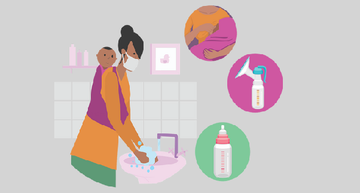Maternal and Child Health Services During COVID-19
Maternal & child health services support women, children, and families, but these services may have been interrupted due to COVID-19. Pregnant women need 8 antenatal checks at 12, 20, 26, 30, 34, 36, 38, and 40 weeks of gestation. Telehealth can be used for some visits, but women need at least 2 in-person visits in the 3rd trimester. Authorities may change policies for services, stay up to date with these policies.
It is safest for a woman to deliver at a health facility, but fear or the stigma of COVID-19 in health facilities may deter women. Engage, listen and respond to their concerns about coming to health facilities during the pandemic. Encourage women to ask as many questions as they like, and answer them to the best of your ability. Pregnant women should wear a mask, keep 2 meters (6ft) apart and come alone for in-person visits.
Breastfeeding During COVID-19

If a mother might have COVID-19, isolate her and her baby together and encourage breastfeeding with a mask. Advise her to exclusively breastfeed for 6 months. Mothers who are too sick to care for or breastfeed should be shown how to express breastmilk. Show her how to safely store the milk and safely feed to prevent infection.
Immunization Services During COVID-19

Children and mothers should not miss routine immunization services. This protects them and others against vaccine-preventable diseases and outbreaks.
To review information on maintaining routine immunization services during COVID-19, refer to course 9.6
How to Continue Nutrition Services
The pandemic made it harder for many families to access nutritious foods that help protect against COVID-19. Monitor food access in your community and watch for malnutrition in children. Pregnant women need a healthy diet. Vitamin A, Vitamin D, and zinc support the body’s immune system.

Pregnant women also need iron and folic acid. Fruits, vegetables and fish are rich in Vitamin A. Dairy and seafood are rich in Vitamin D. Meats, nuts, legumes and seeds are rich in zinc. Meat, root vegetables, and dark leafy greens have iron. Meat, legumes, and green vegetables have folic acid.
Ask mothers and caregivers what food they buy, prepare, cook and serve in daily meals. Know what healthy foods are available locally that mothers and caregivers can use. Also, make sure to monitor children for signs of malnutrition. This includes low weight or weight loss, over weight, lack of interest in eating, drinking, fatigue and weakness. Also monitor for improper growth such as bloated stomach and stunted growth (low weight for height). Show mothers and caregivers how to do the Mid-Upper Arm Circumference (MUAC) screening and when they should seek help from health facilities.
Promote good food hygiene. Remind people to wash hands and rinse fruits and vegetables. Surfaces should be cleaned before and after cooking. People should avoid eating raw meat, meat of sick animals and spinal+brain tissue.


